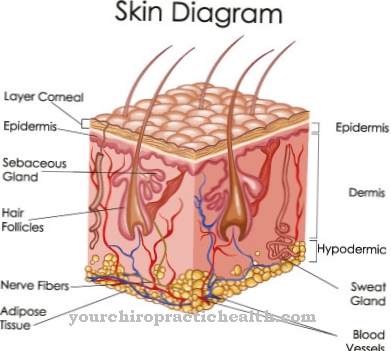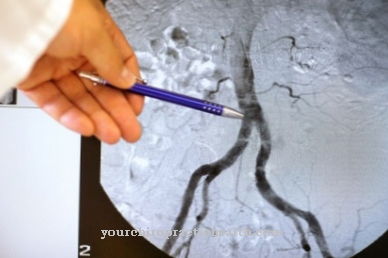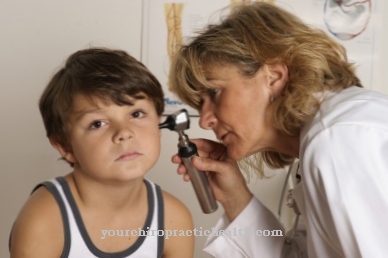The Actinomycosis is a bacterial infection that leads to abscess formation in deeper tissues. The infection is caused by bacteria of the species Aktinomyces. Medicinal and sometimes surgical intervention is used to treat the disease.
What is actinomycosis?

Actinomycetes are rod-shaped bacteria with gram-positive staining behavior. The anaerobes do not form spores and have a microscopic appearance with radial filamentous branches. Actinomyces species are numerous. Some of the human pathogenic species cause so-called actinomycosis. Actinomkyoses are characterized by abscess formation.
The accumulations of pus in the tissues spread to the surrounding tissue and are framed by connective and granulation tissue. The disease is also known throughout Germany as Ray fungus known. The bacterial pathogens enter the blood system through the formation of fistulas, so that bacteraemia occurs for a short time or, in the case of immunodeficient patients, permanent bacteremia.
A complication of bacteremia is sepsis, which corresponds to a systemic inflammatory reaction in the sense of blood poisoning and can take on life-threatening proportions in the context of septic shock. In addition to cervico-facial, thoracic and abdominal actinomycosis, actinomycoses also include cutaneous actinomycosis and various special forms, all of which are caused by Actinomyces.
causes
Actinomycosis is caused by a bacterial anaerobic aerobic mixed infection with Actinomyces. The infection is mainly caused by the species Actinomyces israelii, but Actinomyces naeslundii, viscosus and odontolyticus are also possible pathogens. The species Actinomyces viscosus, for example, can colonize the female urogenital tract. Actinomyces israelii, in turn, are part of the normal human oral flora and live there as commensals.
When the lining of the mouth is injured, the bacteria penetrate deeper tissues. In these deeper layers, they cause purulent inflammation, which is accompanied by the formation of granulation tissue and duct-like fistulas. Actinomycosis in the central nervous system is rare. The same applies to occurrence in the lungs, which can only take place through aspiration of the bacteria.
The disease is also observed less frequently on the skin than in the neck area. Basically, any penetration of the bacteria from the oral flora into deeper tissues can result in actinomycosis. This means that not only inflammation but also fistulas can promote the disease. Nonetheless, invasive dental treatments are considered the most common cause of actinomycosis.
Symptoms, ailments & signs
Actinomycosis patients are affected by abscess formation, the accumulations of pus of which expand to the surrounding tissue and lie in connective and granulation tissue. The colonized tissue is of a coarse consistency, with the pus consisting of inflammatory melted cells, immune components and bacteria.
Abscesses can spread further along the anatomical clefts and thus support the multiplication of the pathogen.
- In the cervico-facial actinomycosis and thus the most common form of the disease, bacteria of the species Actinomyces israelii penetrate deeper tissues through an injury in the mouth and cause an endogenous infection.
- A thoracic actinomycosis Can arise from saliva aspiration, is caused by a widespread cervico-facial actinomycosis, or is caused by bacteria spreading in the blood. In this form, the area of the chest and lungs is affected by the abscesses.
- The abscesses of the abdominal actinomycosis affect the abdominal organs and arise from intestinal injuries or begin in the female genital area. Abscesses of the skin occur in the cutaneous variant, which occurs after injuries with saliva transfer. In some special forms of the disease, the liver and tear ducts are affected by abscess formation, which is mostly due to the spread of bacteria in the blood.
The infection can be accompanied by general signs of infection such as fatigue, fever and chills. If the central nervous system is involved, the abscesses can affect almost all body functions.
Diagnosis & course
In actinomycoses, drusen are formed which correspond to hard granules in the fistula and appear microscopically as an accumulation of bacteria. Based on the medical history, these drusen allow the doctor to develop an initial suspicion of actinomycosis. The cultural proof takes place under anaerobic conditions, but is very complex and takes several weeks. Because of the high rate of recurrence, the prognosis is rather poor. If left untreated, actinomycosis is a life-threatening phenomenon, especially in the thorax area.
Complications
In most cases, actinomycosis does not cause complications. The symptom can be treated relatively well and does not lead to further problems, complaints or restrictions. In most cases, actinomycosis occurs after operations in the oral cavity, in which the person concerned does not observe the necessary hygiene standards.
This can lead to inflammation and the transfer of bacteria into the patient's blood. To prevent actinomycosis, antibiotics can be used prophylactically after an oral surgery. The treatment is carried out without complications. In most cases, only medication is administered for this purpose. However, the treatment itself can last up to a year. However, it hardly affects the patient's life.
Treatment is also possible in the form of a three-month short therapy. In the further course of the disease, surgery can also be carried out. This also does not lead to any further complications. The only complication that can occur is acute blood poisoning. Actinomycosis can recur after treatment. With good hygiene and prophylaxis, however, the probability is very low.
When should you go to the doctor?
In most cases, actinomycosis does not show any particular and characteristic ailments or symptoms. For this reason, an early diagnosis is not possible in most cases. However, those affected always suffer from fever and chills due to the infection. In most cases, those affected also feel tired and exhausted and no longer actively participate in life.
If these complaints occur, a doctor must usually be consulted. Medical treatment is definitely necessary, especially in the case of long-lasting symptoms. The other body functions can also be impaired. If the person concerned has previously had an oral treatment, the symptoms can directly indicate an infection or inflammation.
The attending physician can be consulted. As a rule, actinomycosis can be treated again relatively quickly and easily, so that the symptoms disappear quickly. However, if the symptoms do not point directly to actinomycosis, a general practitioner can be consulted first and foremost.
Doctors & therapists in your area
Treatment & Therapy
Actinomycosis is treated with medication, especially in the early stages. The treatment usually corresponds to the administration of aminopenicillin, which is optimally administered intravenously, especially in the initial stage. The therapy can extend over an entire year. According to current studies, short-term therapy is also possible, which lasts for a maximum of three months.
Medicinal alternatives to aminopenicillin are tetracycline and cephalosporin. In addition, high-dose iodine has shown beneficial effects on disease progression in the past. In the later stages of the disease, a combined drug and surgical therapy is often used. Surgical treatment of abscesses involves opening the focus of inflammation and the doctor removing the affected tissue.
As actinomycosis can lead to the formation of fistulas, systemic blood poisoning is one of the most important complications. In the case of fistulas, invasive treatment is used to remove the duct systems so that the abscess cannot spread into the blood. The disease is associated with a high rate of recurrence and can accordingly recur even after it has healed.
Outlook & forecast
Actinomycosis causes different symptoms. These symptoms do not go away on their own, so treatment by a doctor is always necessary. The person concerned feels sick and tired and suffers from exhaustion. A relatively high fever occurs, which significantly reduces the quality of life of the person affected. There is also chills.
Often paralysis and other disorders of the nervous system can occur, which can make everyday life difficult for the patient. Inflammation and infection develop in the oral cavity, which can make it difficult to eat and drink normally.
Treatment can reduce the symptoms of actinomycosis relatively well and thus fight the disease completely. In most cases, there is no reduced life expectancy or further complaints. However, even with successful treatment, it cannot be guaranteed that actinomycosis will not recur in the patient. Surgical treatment involves removing the affected tissue. Most of the time, however, the person affected also has to take medication so that the disease does not spread.
prevention
To prevent actinomycosis, patients usually receive antibiotic prophylaxis before and after operations in the mouth area in order to prevent the oral flora from entering the blood.
You can do that yourself
In the case of actinomycosis, the most important measure is an immediate medical evaluation and treatment of the disease. The bacterial infection is usually treated with medication. The patient can support the therapy with a few measures and various means from the field of naturopathy.
First of all, rest and bed rest are important. Since abscesses are often associated with fever, malaise and other complaints, the immune system in particular must be supported. This is best achieved through a healthy lifestyle with sufficient exercise, a balanced diet and avoidance of stress.
If the disease has already spread to the oral mucosa, various nourishing ointments from naturopathy can be used. Mouth rinses are also useful for inflammation in the mouth. If the skin is affected, a number of natural ointments and other preparations are also available. In addition, strict personal hygiene should be observed in order to avoid complications as far as possible.
If the measures mentioned do not have any effect or even cause further complaints, the responsible doctor must be informed. In general, close medical monitoring is indicated in the case of actinomycosis.













.jpg)

.jpg)
.jpg)











.jpg)